
by Cora Buhlert
Science Fiction at the Newsstand

Ever since its debut almost five years ago, West German science fiction has been synonymous with the dime novel series Perry Rhodan. Issue 258 of Perry Rhodan came out this week and so far, the series shows no sign of faltering.
Success breeds imitators and so there have been challengers for the crown of West Germany's premier science fiction series. The first challenger Mark Powers was hampered by old fashioned and inconsistent plots and so the series was discontinued in 1964, though Mark Powers still occasionally pops up in the pages of the anthology series Utopia Zukunftsroman.
This month, a new challenger appeared on West German newsstands. Ren Dhark is penned by former Perry Rhodan writer Kurt Brand and published by Kelter Verlag. Only one issue has come out so far, but what I've read looks promising.
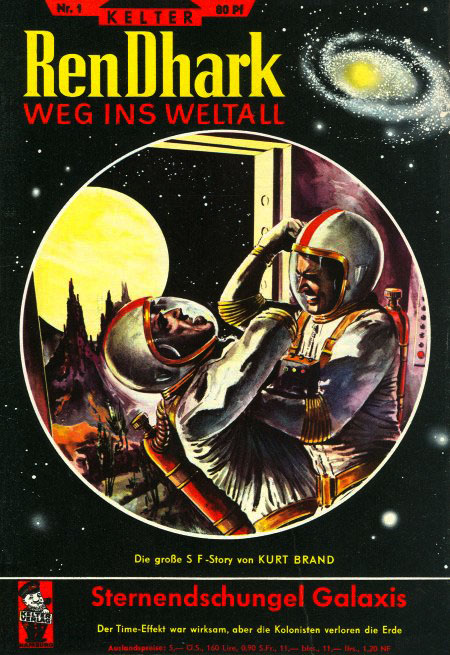
The story begins in the far off future of 2051 AD, when overpopulation – a popular theme in current science fiction, as Harry Harrison's Make Room, Make Room! and several of the stories collected in Orbit 1 show – forces humanity to look for a new home among the stars. So the starship Galaxis under the command of Captain Sam Dhark (no reason is given for the odd spelling of the name) departs for Deneb with fifty thousand colonists. However, the time effect drive malfunctions, stranding the Galaxis in the depths of space, turned into an involuntary generation ship.
Eventually, the Galaxis, now commanded by the titular Ren Dhark, son of the late captain, manages to find a habitable planet. But their problems have only just begun, because the planet in question is not only habitable, but also inhabited…
Ren Dhark started out promising enough, though not particularly innovative. Nonetheless, I will certainly haunt the newsstand on the lookout for issue 2.
Science Fiction at the Spinner Rack
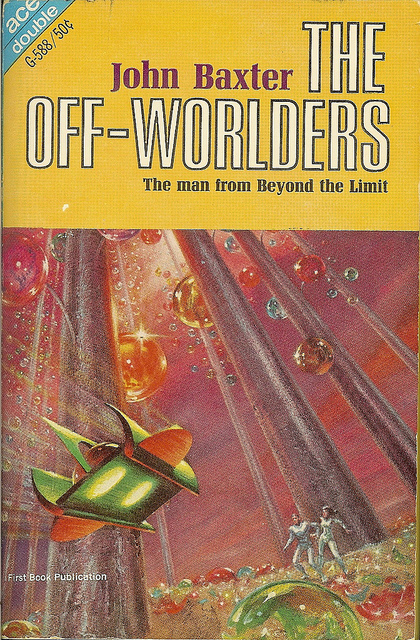
However, my main source of new science fiction is still the spinner rack at my local import bookstore. And during my last visit, I managed to snap up the latest Ace Double, number G-588 to be exact, which includes The Off-Worlders by John Baxter and The Star Magicians by Lin Carter.
The Off-Worlders has just been serialised in New Worlds under the title The God Killers, so I'll just point you to Mark Yon's review of the novel and delve right into the other half of this Ace Double.
Most readers of the Journey will probably know Lin Carter mainly from his "Our Man in Fandom" columns in If, but he is also an up and coming science fiction and fantasy writer. Erika Frank reviewed his sword and sorcery novel The Wizard of Lemuria last year. Now, Carter has set his sights on space opera, though barbarians still feature prominently.
A Familiar History
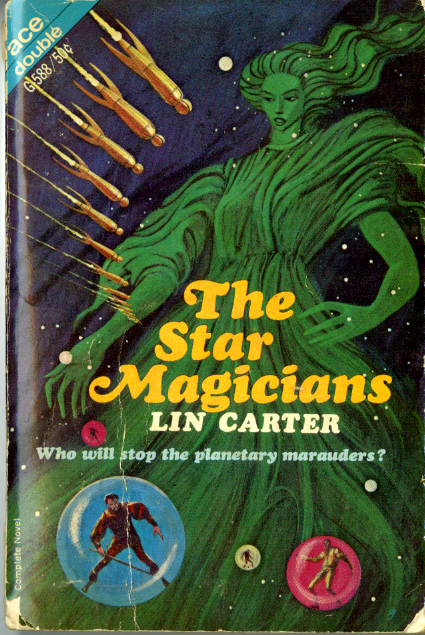
The Star Magicians begins with one of those dreaded information laden prologues which occasionally afflict science fiction novels. In fact, when I read the capsule history of the fall of the Great Carina Empire, I briefly wondered whether I had accidentally picked up a later book in an ongoing series.
But even if there is no previous novel in the series, the history of the Carina Empire, which is beset by barbarians at its borders and eventually breaks apart and descends into a new dark age, will seem familiar to anybody who knows even a lick of history, for here is the fall of the Roman Empire replayed once again in outer space.
However, one planet stands firm against the new dark age and the barbarian Star Rovers: the planet Parlion, which is inhabited by a group called the White Wizards, who preserve science and technology and are considered magicians by their less enlightened neighbours. If that story seems familiar, it's probably because you've read it before when it was still called Foundation and penned by Isaac Asimov.
Naked Bodies and Tortured Metaphors
Once the actual plot begins, the novel becomes more engaging, though not necessarily better or more original. The story proper opens in an arena, where a would-be Conan gladiator is fighting against an alien monster, while the barbarian warlord Drask looks on and fondles a naked girl.
The naked girl is a captive princess, though you wouldn't know it from the first chapter. Carter repeatedly starts and then fails to describe the young woman, getting sidetracked by reminiscing about the conquest of the planet in a pitched space battle, describing the chafing and sweat-soaked leather and iron garb of a barbarian warrior and lovingly detailing the manly vigour and magnificent body of the gladiator (who will be dead within two pages, his "nakedness clothed in dripping scarlet").
Here's a typical example of Lin Carter's tortured prose. If this is too much for you, best bail out now, because the entire book is like that:
Above, in the royal box, Drask reclined at his ease on the satin cushions, half his cynical attention on the tragic drama unfolding below, and half on the trembling young girl beside him, whose nude breasts he was idly fondling. A philosopher in his rough way, the Warlord of the Star Rovers mused on the changeful ways of Fate. In this moment of time the young Argionid swordsman was filled with robust life, bursting with manly vigor in the full hot morning of his youth… in the next moment, his splendid, virile body would be an awful bundle of bloody rags, crushed in the inexorable jaws of the slavering thard.
We are toys at the feet of the gods, he thought.
When Carter finally remembers to describe the young princess – or rather her breasts – he compares them to "warm, white fruit", at which point I wondered whether Carter has ever seen a naked woman, or eaten fruit, for that matter.
After the would-be Conan has met his demise, we are finally introduced to the actual protagonist, Perion of North Hollis (which sounds like a stop on the London Underground rather than a city on an alien planet), a minstrel sentenced to die in the arena for treason. However, Perion manages to outwit the monster and is pardoned and even invited to a feast of the Star Rovers, where he further ingratiates himself by stopping the captive princess from stabbing the warlord Drask. Her attempt at revenge foiled, the princess stabs herself and is forgotten within a page. We never even learn her name nor anything about her appearance except that she has breasts.

White Wizards and Green Goddesses
What follows is a clunky and exposition laden dialogue, which not only repeats information we already got in the equally clunky prologue, but also reveals that there is only one person who can stand against the mighty warlord Drask, namely Calastor, one of the White Wizards of Parlion. Not only does Calastor have superior quasi-magic technology, he also has dozens of minions willing to do his bidding. Worse, no one knows what he looks like. "For aught we know, he might be standing among us at the very moment," mutters one of the few named Star Rovers at the feast. Anybody who has read Isaac Asimov's Foundation series may develop certain suspicions at this point.
Since the princess committed suicide, Drask is in need of a new bed companion and picks a random dancing girl, who promptly tries to stab him again. Even Drask, who's not the sharpest knife in the drawer, thinks that two assassination attempts in one night are a little much to be a coincidence. So he examines the dagger with which the girl tried to stab him and finds a glowing green stone, a talisman dedicated to the Green Goddess of Malkh. The dancing girl is one of her priestesses. For it turns out that Drask has not one but two sworn enemies in the galaxy, the White Wizard and the Green Goddess. Of course, it might have been helpful if Carter had mentioned that tidbit of information before.
The interrogation of the dancing girl, whose name is revealed to be Lurn, reveals nothing, because Lurn downs a potion that – no, this time around, the potion doesn't kill her, it only makes her fall asleep. When the sleeping Lurn is taken to the dungeon for further interrogation, she vanishes into thin air.
Lurn reappears on the next day, hidden in Perion's baggage, which leads to both her and Perion being arrested. During their interrogation, Perion is unmasked as none other than Calastor, the White Wizard and sworn enemy of Drask. This turn of events might have been a genuine surprise, if Carter hadn't borrowed it wholesale from "The Mule" part of Isaac Asimov's Foundation trilogy. And just in case you failed to notice the parallels, Perion is even shown with a (pack)mule shortly before his arrest. In fact, the only surprise is that the reveal happens halfway through the novel rather than at the end, as I expected.
Calastor and Lurn escape Drask by teleporting to safety and engage in yet another exchange of long explanations aboard Calastor's spaceship. Calastor reveals that he must stop Drask and the Star Rovers soon, because they are threatening the planet that the White Wizards of Parlion have picked out as the nucleus of the new galactic empire they are trying to build.
Smoke and Mirrors
The story now heads to Xulthoom, the planet of mists and also the planet that drives men mad. Xulthoom is a fascinating setting with its ancient ruins and perpetual mists and I wonder what e.g. Leigh Brackett could do with it. Lin Carter does not nearly have Leigh Brackett's skills, but even he manages to convey the spooky atmosphere of Xulthoom.
Calastor uses his quasi-magical science to mentally destabilise the Star Rovers and turn them against each other, while gizmo-speaking to Lurn and spouting an amount of nonsense about psionics that would impress even John W. Campbell.
Due to Calastor's manipulations, the Star Rovers go mad one by one and begin to hear voices. Some literally die of fear. In the end, even Drask himself hears a voice, supposedly that of the Green Goddess, warning him to return to the Rim Stars whence he came or suffer the consequences. However, the message from the Green Goddess is not Calastor's doing. There is another power at work here.
Spooked by the message of the Green Goddess, Drask finally gives the order to abandon Xulthoom – no, not to go home, but to conquer the next planet, the one planet that the White Wizards want to keep the Star Rovers away from at all costs.
Calastor summons some help from Parlion and together the White Wizards attempt to dissuade the Star Rovers from travelling onwards by projecting an illusion of space dragons attacking the fleet. However, the Star Rover shaman Abdekiel, an offensive Asian stereotype who is frequently likened to a "butter yellow buddha", sees through the ruse.
So Calastor and his companions teleport aboard the Star Rover flagship to face Drask and his men directly. The White Wizards use their mental powers to disarm the barbarians, while Calastor gets involved in a prolonged and remarkably well described swordfight.
The standoff is interrupted by the Green Goddess herself, who thoroughly smites the Star Rover fleet, a scene strikingly illustrated by Jack Gaughan on the cover. Finally, the Goddess teleports the adversaries away, metes out punishment to Drask and gives her blessing to the marriage of Calastor and Lurn (who turns out to be a princess as well), who will rule together over the world that will become the nucleus of the new empire.
An Unholy Mess
Lin Carter was aiming for Isaac Asimov's Foundation as written by Robert E. Howard. However, Carter has the skill of neither Asimov nor Howard and so the result is just a mess.
One technique that Carter borrows from Robert E. Howard is Howard's tendency to begin a story with a supporting character before his barbarian adventurer Conan steps onto the scene. But while Howard never leaves any doubt that Conan is the hero of the story, Carter seems unsure which of his characters is the protagonist. By rights, Calastor and Lurn should be the stars, but Calastor vanishes for chapters at a time and Lurn never even acquires a personality, so Drask, the villain, is the closest thing to a protagonist this unholy mess of a novel has.
Make no mistake, this is a terrible book. It's certainly the worst book I have ever reviewed for Galactic Journey. The plot is hackneyed, the prose is tortured and so purple that it almost crosses over into ultraviolet. In fact, this book is so awful that I wonder how desperate Ace must have been to publish it. If there was a Hugo Award for the worst science fiction novel, The Star Magicians would be the uncontested winner.
However, this novel has one redeeming feature: it is at least entertainingly terrible. In fact, the book is utterly hilarious. I was giggling the whole time I read it and regaled friends and family members with reading Lin Carter's awful prose out loud. If The Star Magicians were a parody, it would be absolutely brilliant. But unfortunately, it's supposed to be a serious space opera adventure.
I'm sure there is something that Lin Carter excels at and I hope that he will eventually find it. However, writing science fiction is not it.
One and a half stars


Rosel George Brown's new hit novel, Sibyl Sue Blue, is much better than Lin Carter's book. You might want to get the taste out with it!

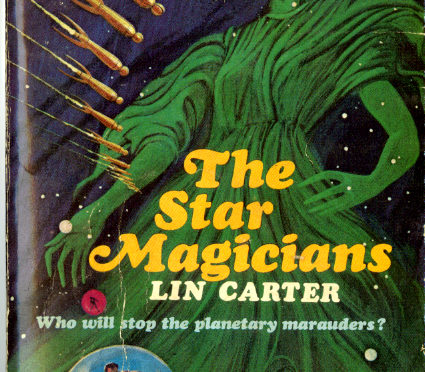
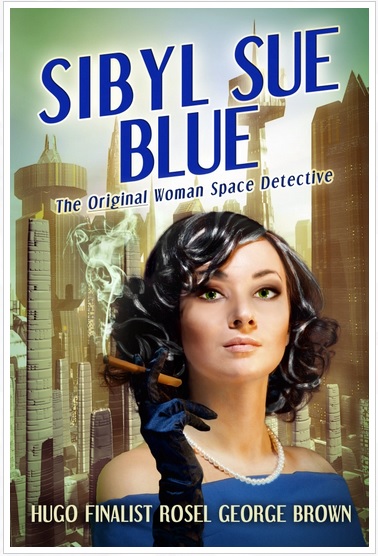

Splendid evisceration. Just leave the pieces by the roadside, they're not worth burying.
I still wouldn't dump the book by the roadside, it would be littering and some innocent person might pick it up.
Carter might have better luck with sword and sorcery in some mythical past society- Atlantis may be played out, but how about Lemuria?
Pure sword and sorcery might be more of his thing than this mix of space opera and what Fritz Leiber calls sword and superscience.